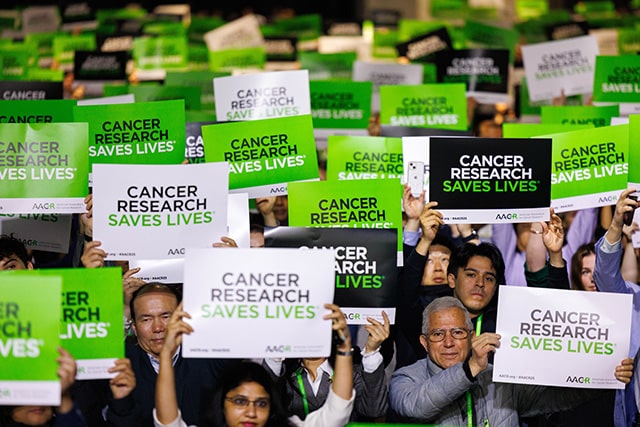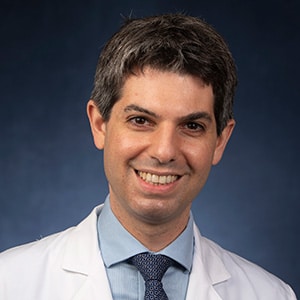Day three of the AACR Annual Meeting 2025 saw attendees rise in support of robust and sustained funding for the National Institutes of Health (NIH), a panel discussion—that included former NIH Director Monica M. Bertagnolli, MD—on the far-reaching impact of cuts to the NIH, and an Opening Plenary that emphasized the meeting theme and illustrated the breadth of cancer research captured at the meeting. Read on for the takeaways from Sunday, April 27 to get a flavor of today’s offerings and keep an eye on Cancer Research Catalyst, the official blog of the AACR, for more in-depth coverage of some of the cutting-edge science presented at the AACR Annual Meeting 2025.
New AACR Trailblazer Cancer Research Grants Announced at Opening Ceremony
During the Opening Ceremony, attendees rose to their feet waving signs that read “Cancer Research Saves Lives” as AACR CEO Margaret Foti, PhD, MD (hc), and AACR President Patricia M. LoRusso, DO, PhD (hc), FAACR, encouraged the cancer community to make their voices heard about the importance of funding for medical research. Further, to help address the funding challenges facing today’s cancer researchers, they announced the new AACR Trailblazer Cancer Research Grants. In total, 15 grants of $1 million each will be given to nine early-stage and six mid-career investigators—the largest single grant program the AACR has ever offered.
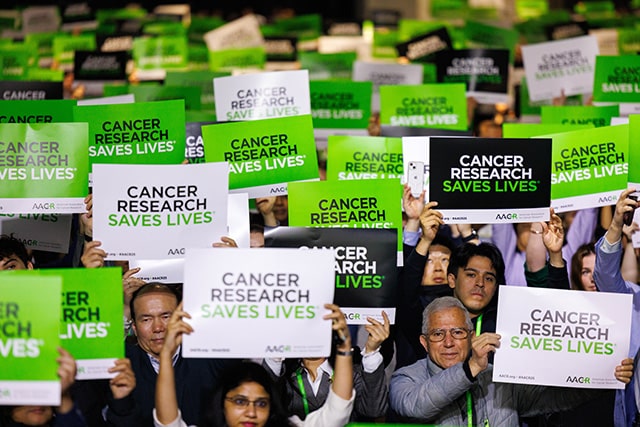
“By funding innovative and paradigm-shifting research, these AACR Trailblazer Cancer Research Grants will advance our understanding of cancer biology, drive groundbreaking translational discoveries, and improve patient outcomes,” Foti said.
Additionally, several of this year’s award winners were recognized through the ceremony. Read more about the recipients of the scientific achievement and public service awards on AACR Annual Meeting News. And read the press release detailing the amazing stories produced by this year’s recipients of the AACR June L. Biedler Prize for Cancer Journalism.
Opening Plenary Exemplified Meeting Theme With Diverse Research Topics
The “Opening Plenary: Unifying Cancer Science and Medicine—A Continuum of Innovation for Impact” expanded on this year’s meeting theme of carrying scientific discoveries through to meaningful clinical impact and featured four leading researchers speaking on a range of scientific topics.
Kevan M. Shokat, PhD, FAACR, who developed the first FDA-approved KRAS inhibitor sotorasib (Lumakras), presented new strategies for targeting this oncoprotein, which was long considered undruggable.

Paul S. Mischel, MD, FAACR, examined the many contributions of extrachromosomal DNA (ecDNA) to cancer and the therapeutic opportunities it presents.
“We’ve come a long way in understanding the importance of [ecDNA] … It’s very prevalent, and it’s very devastating,” said Mischel. “I hope you will take away how important this type of biology is and why we have to tackle it.” Reflecting the emerging implications of ecDNA in cancer, AACR members identified this topic as one of high interest, and the Major Symposium “ecDNA Amplifications and Genomic Rearrangements: Drivers, Pathology, and Therapeutic Opportunities” was also held today.
The next speaker was Johanna A. Joyce, PhD, FAACR, who discussed the interactions between cancer cells and immune cells within the tumor microenvironment TME and how these interactions may impact cancer treatment and drug resistance.
Finally, Catherine J. Wu, MD, FAACR, discussed the potential of cancer vaccines to target the continuously evolving tumor ecosystem.
Concurrent with today’s session, Mischel and Wu published commentaries on ecDNA and cancer vaccines, respectively, in the AACR journal Cancer Discovery:
Cancer Research at a Crossroads Session Looks at How Researchers Can Better Advocate for Science
“This [is a] moment when the future of cancer research and the integrity of science feels more uncertain than in any other point in my career,” LoRusso said during the session “Cancer Research at a Crossroads: Sustaining Progress Against Cancer for the Benefit of Patients.” She shared results from an AACR survey that reflected how many other researchers felt similarly:
- 70% of respondents had seen delays in PhD or postdoc admissions;
- 45% reported losing access to fellowships, NIH research career development (K) awards, and training grants;
- 55% said their colleagues are leaving the field;
- 25% reported delays or cancellations of clinical trials; and
- 68% were asked to reframe or redirect their research, particularly if it related to politically sensitive topics.
“We are navigating political interference, institutional instability, and growing uncertainty across the cancer enterprise,” LoRusso explained. “These are not routine challenges, they demand clarity, courage, and collective resolve.”
One of the goals of this session was to offer researchers advice and insights from an esteemed panel of individuals who shared what can be done to help overcome these challenges.
A common theme that emerged was communication—to all parties. LoRusso said in that same survey, only 50% of respondents had contacted their members of Congress. She encouraged everyone to reach out to talk about the impact of cuts to medical research funding.
As the former NIH director, Bertagnolli ensured attendees that elected officials really want to do what is best for the public, but it is still important to “fight for your science … fight for what you do that benefits the American people.” She added we have already seen examples of programs the administration eliminated only to reverse course when the benefits of those programs were made clear.

Former NCI Director W. Kimryn Rathmell, MD, PhD, emphasized the need to communicate outside of own echo chambers. For example, she has talked with people about cancer research at community groups, nursing homes, the airport, and even Staples.
E. John Wherry, PhD, FAACR, said we should also share information about the benefits of NIH funding on society as a whole. For example, how NIH funding also fuels the economy—NIH-funded patents are 20% more efficient in generating future economic activity than patents funded outside the NIH.
But stories of how NIH is saving lives can also be powerful as patient advocate Larry Saltzman, MD, said he is “living proof of what NIH research has done” as someone who has been kept alive by participating in clinical trials. While Kristen Dahlgren, another patient advocate, is a journalist working on a documentary about the impact of the cuts to the NIH.
“We have to tell stories like their lives and the lives of their loved ones depend on it, because they do,” she said.
Cody L. Wolf, MS, PhD, who represented the perspective of early-career researchers, said many of his colleagues still have hope—even if they have lost their funding.
“They said they are here at this conference to … do good science. I’m here to do what I love. It really enlightens me that even in such a tumultuous time for us, there’s still so much hope.”
Presidential Address Examines the Future of Personalized Oncology
In her Presidential Address, “From Hierarchical Molecular Composition to Transforming Oncology Drug Development,” LoRusso discussed her hope for the future of personalized oncology. Currently, she believes we are at the most basic level of personalized oncology, “personalized oncology 101,” but advances in various areas of research can help provide the knowledge needed to advance the field. For example, she pointed to how understanding changes to transcription factors could eventually help overcome resistance to treatment, how the power of phosphoproteomic-based approaches will help researchers better understand the working machinery behind a disease and provide a way to map what drugs would work in what patients, and how spatial transcriptomics can offer a look at the geography of tumor cells to see where treatments are having an effect.
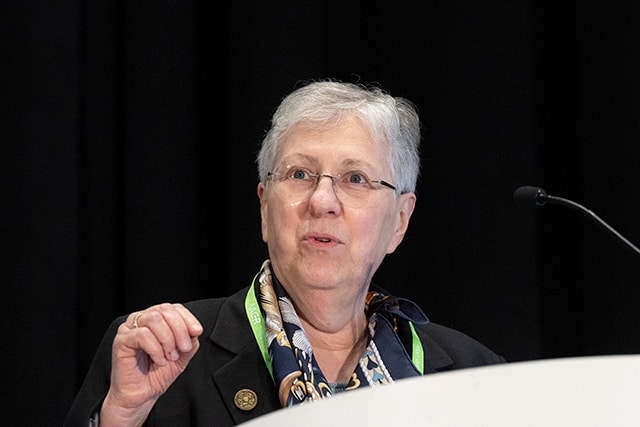
“What we need to do is bring this information together—bring all of these puzzle pieces together in an integrated advanced computational analysis and modeling format, so that we can truly personalize medicine for our patients,” she said.
LoRusso also wants to apply some of these principles to the first trial to come out of the AACR Center for Cancer Clinical Trials. This neoadjuvant biomarker-driven trial in patients with gastroesophageal adenocarcinoma should start enrollment by the end of this year. The trial will match patients to targeted therapies and test whether treatment is effective enough to spare patients from organ-removing surgery.
Clinical Trials Program Kicks Off With Groundbreaking Clinical Research
The opening Clinical Trials Plenary Session—chaired by AACR Past President Antoni Ribas, MD, PhD, FAACR, and Jayesh Desai, MBBS—focused on immunotherapy’s expanding impact in different settings.
Desai welcomed the audience to the first session of “a really exciting and impactful clinical trial science program.”

The session began with Ravindra Uppaluri, MD, PhD, highlighting results from the phase III KEYNOTE-689 study with practice-changing implications for patients with newly diagnosed head and neck squamous cell carcinoma (HNSCC). When administered before and after surgery to supplement adjuvant care, pembrolizumab improved responses and progression-free survival in patients with previously untreated, locally advanced HNSCC, compared to standard of care alone.
“This is very exciting because in head and neck cancer, in particular, this sets the stage for us to think about other approaches,” Uppaluri concluded.
The next two talks—by Yelena Y. Janjigian, MD, and Andrea Cercek, MD, discussed the benefits of PD-1 blockade in patients with solid cancers characterized by mismatch repair deficiency (dMMR). Whereas Cercek demonstrated that immunotherapy can eliminate the need for surgery in patients with early-stage dMMR tumors, Janjigian revealed that adjuvant immunotherapy can clear minimal residual disease in patients with dMMR cancers who have detectable circulating tumor DNA after surgery.
Concluding the session, Timothy Yap, MBBS, PhD, showcased the potential of combining PD-1 immunotherapy with the PARP inhibitor olaparib. In patients whose cancers had certain DNA repair defects, the combination approach proved effective in patients who have a mutant form of BRCA.
The exciting slate of clinical research continued with a second Clinical Trials Plenary Session focused on targeted therapies across various solid tumor types. Ryan B. Corcoran, MD, PhD, who served as a cochair of both the session and this year’s Annual Meeting Clinical Trials Committee, reiterated the robust nature of this year’s Clinical Trials Program.
“We were lucky to receive a number of really interesting and impactful abstracts this year,” Corcoran said. “This session is no exception.”
Highlights from this session included a first-in-human trial of a Werner helicase inhibitor that showed clinical benefit in patients with solid tumors characterized by microsatellite instability or dMMR, as well as a paradox-breaker BRAF inhibitor that evoked responses in patients with BRAF V600E-mutated solid tumors.

But in a third study, researchers embraced the BRAF inhibitor paradox, in which BRAF inhibition can paradoxically activate upstream signaling of the epidermal growth factor receptor (EGFR), instead of trying to suppress it. Anisha B. Patel, MD, reported that a topical BRAF inhibitor gel applied to the acneiform rash some patients develop while taking EGFR inhibitors could soothe the rash better than a placebo gel by reactivating EGFR signaling locally.
The session closed with promising results from a phase I clinical trial testing the investigational KRAS G12D inhibitor zoldonrasib in patients with previously treated KRAS G12D-mutated non-small cell lung cancer (NSCLC). Kathryn C. Arbour, MD, observed an objective response rate of 61% and a disease control rate of 89% among patients who had received treatment for at least eight weeks.
New Drugs on the Horizon Sessions Preview Eight Therapeutic Molecules
“Cancer drug discovery has always been challenging,” said Lori S. Friedman, PhD, the chair of both the first New Drugs on the Horizon session and of the AACR Chemistry in Cancer Research (CICR) Working Group Steering Committee. The New Drugs on the Horizon sessions, organized by the CICR Working Group, present new drugs to the scientific community for the first time.
“We learn a lot, we try to apply that [knowledge] to help patients, and we hope that by working together, we will continue to bring benefit to patients,” said Friedman.
In pursuit of that goal, the first two New Drugs on the Horizon sessions unveiled the structures of eight new therapeutic molecules, including two designed to target oncogenic RAS signaling (AMG 410 and RMC-5127). Reflecting the importance of the immune system against cancer, three of the new molecules take aim at immune-related pathways: the novel HER2 x CD3 T-cell engager ABP-102/CT-P72 and two unique FAP-targeting drugs (the radioligand FXX489 and the bispecific RO756713 that also targets the LTBR pathway). Lastly, drugs targeting the androgen receptor (GDC-2992), PSMA and STEAP1 (ABBV-969), and the Helios and Eos transcription factors (BMS-986449) were presented.
Minisymposium Explored Innovative AI-driven Approaches to Enhance Cancer Care
In today’s “Artificial Intelligence and Machine Learning for Basic and Translational Research” Minisymposium, proffered presentations focused on potential applications for artificial intelligence (AI) and machine learning (ML) in cancer research and treatment.
“This session highlights really exciting research showing how AI and ML can leverage multiple modes of data to improve different kinds of predictions, from diagnoses, subtyping of cancers, targeted therapies, and prognoses,” said Samantha Riesenfeld, PhD, who co-moderated the session.
As one example, Sabeen Ahmed reported a new, multimodal AI-driven biomarker model that integrates data from routinely collected imaging scans, lab tests, and clinical notes to compute the probability that a patient has or will develop cancer cachexia, a debilitating complication of cancer that is often caught late and leads to an estimated 30% of cancer deaths. Standard methods to detect cancer cachexia can be subjective and inconsistent, the presenter noted, but the multimodal AI-driven biomarker model identified cancer cachexia in pancreatic cancer patients with 85% accuracy.
In another presentation, Steven Song discussed how pretrained, “off-the-shelf” AI-driven models could help diagnose nonmelanoma skin cancers, potentially even in settings with limited access to expert pathologists and without the resources to develop bespoke AI models. The pretrained AI models (PRISM, UNI, and Prov-GigaPath) are designed to analyze digital images of pathology slides and determine whether the tissue is likely to include cancer. All three pretrained models significantly outperformed a standard baseline model in correctly identifying cancer, even when the models were simplified to be more amenable to resource-limited settings.
Sessions Examined Contributions of the Environment and Diet to Cancer
The afternoon also featured sessions on environmental and dietary risk factors for cancer. In the “Emerging Environmental and Dietary Risk Factors for Cancer: Ultra-Processed Foods, Microplastics, and Per- and Polyfluoroalkyl Substances” session, researchers summarized the current understanding of these three prevalent exposures, which “have raised some alarms due to their potential effect on cancer,” according to session moderator Mingyang Song, MBBS, ScD. Song noted that all three exposures are ubiquitous (making them nearly impossible to avoid), contain multiple constituents (which complicates risk assessment), and have carcinogenic potential.
During the “Dharma Master Jiantai Advances in Lung Cancer Research Session: Aging and Environmental Cues Drive Lung Cancer Development and Spread” session, researchers explored nonsmoking factors that increase the risk of lung cancer, including exposure to air pollutants as well as aging-related inflammation and metabolic changes. The session’s namesake, Dharma Master Jiantai, was a never-smoker who died of lung cancer at a time when no targeted therapies were available for the mutation in her tumor.
Researchers Honored for Pioneering Contributions to Cancer Research
The day also included award lectures from six esteemed researchers who were recognized for their impactful contributions to cancer research.
Douglas Hanahan, PhD, FAACR, spoke on “Illuminating and reprogramming the immuno-evasive tumor microenvironment to enable immunotherapy,” as the recipient of the Pezcoller Foundation-AACR International Award for Extraordinary Achievement in Cancer Research. Hanahan received this award for uncovering the molecular mechanisms required to drive cancer growth and helping to establish the principle that malignant traits in cancer are conferred by cooperative interactions between cancer cells and co-opted host cells recruited into the tumor microenvironment. His award lecture discussed reversing the systemic immunosuppression of a therapeutic oncoprotein vaccine in HPV16-driven squamous cell carcinoma—results that were published in Cancer Discovery today.
Rakesh K. Jain, PhD, FAACR, delivered his lecture, “Normalizing the tumor microenvironment to improve cancer treatment: Bench to bedside and back.” Jain received the AACR Award for Lifetime Achievement in Cancer Research for his pioneering contributions to the scientific understanding of the tumor microenvironment and its role in cancer progression and treatment.
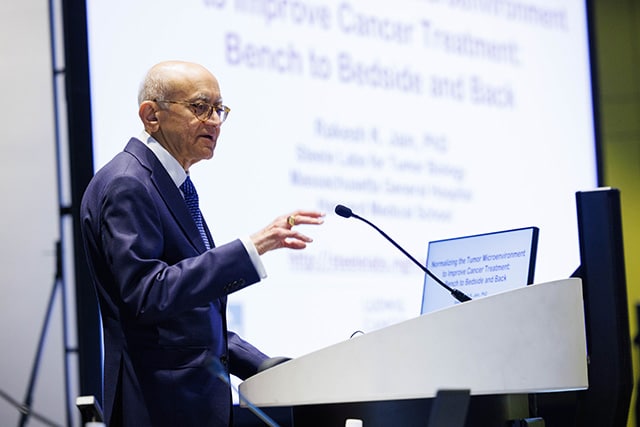
Matthew L. Meyerson, MD, PhD, FAACR, discussed “Cancer genomics: diagnostics and targeted therapy.” Meyerson received the AACR James S. Ewing-Thelma B. Dunn Award for Outstanding Achievement in Pathology in Cancer Research for his significant discoveries including the identification of key oncogenic mutations and the development of genomic diagnostic approaches that have driven major advancements in cancer diagnostics and treatment.
Daniel J. Drucker, MD, delivered the AACR-Irving Weinstein Foundation Distinguished Lectureship titled “Changing health outcomes with GLP-1 medicines.” Drucker was awarded this lectureship for his scientific contributions to endocrinology, physiology, and metabolism, including the elucidation of glucagon-like peptide (GLP) function in modulating insulin secretion, blood glucose levels, appetite regulation, and nutrient absorption.
Ronald A. DePinho, MD, FAACR, presented the AACR-Princess Takamatsu Memorial Lectureship titled “The age of cancer: Insights and interception.” DePinho was honored for his groundbreaking contributions to telomere biology in cancer and aging, including the creation of the first telomerase knockout mouse, which demonstrated how telomere dysfunction links cancer and aging.
Toni K. Choueiri, MD, delivered his award lecture, “Towards a precision medicine approach in renal cell carcinoma.” Choueiri received the AACR-Wuan Ki Hong Award for Outstanding Achievement in Translational and Clinical Cancer Research for his transformative advancements in the treatment of renal cell carcinoma (RCC), which significantly extended patient survival rates for those with metastatic and high-risk disease.
Enjoy Researchers Who Know How to Rock
Now that you are caught up on today’s sessions, consider heading to the Annual Reception, which goes on to 11:30 pm CT (if you aren’t there already), at the Skyline Ballroom (Room W375 ABC in McCormick Place West) for a not-to-be-missed performance by The CheckPoints. This cover band was originally founded in 2007 by Patrick Hwu, MD, Rachel Humphrey, MD, and Thomas F. Gajewski, MD, PhD, but now includes more than a dozen members who are either researchers, oncologists, or other professionals working in the field of immuno-oncology. Learn more about each member and what they love to perform in this blog post. Come prepared to dance and cheer for more cowbell (read the post to find out why)!
Visit the virtual platform to view any of the scientific sessions or e-posters through October 2025. For more coverage of the meeting, go to AACR Annual Meeting News, check out the takeaways from each day, and subscribe to Cancer Research Catalyst.
The post Daily Takeaways From the AACR Annual Meeting 2025: Sunday, April 27 appeared first on American Association for Cancer Research (AACR).
